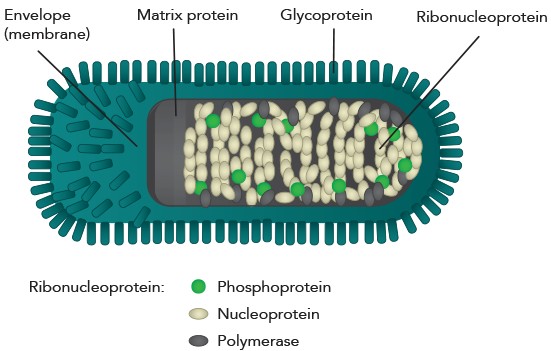Every 10 Minutes in the United States, Someone Is Treated for a Potential Rabies Exposure1
The virus has a capacity to kill 99.9% of the people who become infected, making it one of the deadliest diseases in the world.2,3
The Rabies Virus
Once rabies enters the central nervous system, it is almost 100% fatal4
- Human infection occurs when the virus is transmitted through the saliva of an infected animal either by a bite or scratch5
- Once a person infected with the rabies virus becomes symptomatic (fever, headache, discomfort), no treatment is proven to prevent the progression to death.2
KEDRAB Works Immediately to Stop the Rabies Virus From Spreading6

Adapted from Centers for Disease Control and Prevention.7
The Rabies Virus Is Sometimes Too Challenging for the Human Immune System to Fight2,4
- Proper administration of KEDRAB human rabies immune globulin prevents the rabies virus from advancing into the bite victim’s central nervous system long enough for the vaccine to boost the patient’s own natural immune response.4,6
- Because the incubation period for rabies in a given person cannot be readily predicted, delivering antiviral antibodies with a human rabies immune globulin, such as KEDRAB, as soon as possible after exposure is recommended. Delays are potentially lethal.4
Treatment of Patients Exposed to the Rabies Virus Is Time-Sensitive
The Five Clinical Stages of Rabies4,8* |
|||||
|---|---|---|---|---|---|
| Incubation | Prodrome | Acute Neurological Phase | Coma | Death | |
| Duration | 5 days to >2 years | 0 – 10 days | 2 – 7 days | 5 – 14 days | Variable |
| Symptoms8 | None | Fever Anorexia Nausea Vomiting Headache Malaise Lethargy Pain or paresthesias at bite site | Hyperventilation Hypoxia Aphasia Lack of coordination CNS signs (paresis, paralysis) Hydrophobia Pharyngeal spasms Confusion Delirium Hallucinations Marked hyperactivity Anxiety Agitation Depression | Pituitary dysfunction Hypoventilation Apnea Hypotension Cardiac arrhythmia Cardiac arrest Coma | Pneumothorax Intravascular thrombosis Secondary infections |
*Adapted from CDC Advisory Committee on Immunization Practices 2010.4
- A variable incubation period exists between exposure to the rabies virus and the appearance of symptoms—usually 1 to 3 months, but it could vary from 5 days to more than 2 years4
- KEDRAB® (Rabies Immune Globulin [Human]) should be given as soon as possible after exposure, but no later than 7 days after the first dose of vaccine6

The Importance of Proper PEP
Learn more about how proper PEP administration can help prevent the rabies virus from spreading.
References: 1. Centers for Disease Control and Prevention. CDC Vital Signs. Rabies: A Forgotten Killer. June 12, 2019. https://www.cdc.gov/vitalsigns/rabies/. Accessed December 20, 2023. 2. Rupprecht C, Kuzmin I, Meslin F. Lyssaviruses and rabies: current conundrums, concerns, contradictions and controversies. F1000Research. 2017;6(F1000 Faculty Rev):184. doi: 10.12688/f1000research.10416.1. 3. Fooks AR, Banyard AC, Horton DL, Johnson N, McElhinney LM, Jackson AC. Current status of rabies and prospects for elimination. Lancet. 2014;384:1389-1399. 4. Centers for Disease Control and Prevention. Use of a reduced (4-dose) vaccine schedule for postexposure prophylaxis to prevent human rabies: recommendations of the Advisory Committee on Immunization Practices. MMWR Morb Mortal Wkly Rep. 2010;59(2):1-9. 5. Data on file. Kamada Ltd. 6. KEDRAB [package insert]. Fort Lee, NJ: Kedrion Biopharma Inc.; 2021. 7. Centers for Disease Control and Prevention. What is Rabies? November 30, 2020. https://www.cdc.gov/rabies/about.html. Accessed December 20, 2023. 8. Consales CA, Bolzan VL. Rabies review: immunopathology, clinical aspects and treatment. J Venom Anim Toxins Incl Trop Dis. 2007;13(1):5-38.
